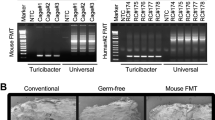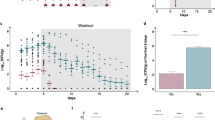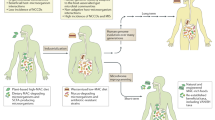Abstract
WHILE the existence of a symbiotic relationship between man or animals and micro-organisms was recognized as early as the times of Pasteur and Metchnikoff1, little is known concerning the evolution, complete identification, survival factors and the mechanisms which control the beneficial or pathogenic activities of the intestinal flora. Recently, however, model systems for examination of the intestinal flora have been made available in the establishment of germ-free2, gnotobiotic (known flora)2 and specific pathogen-free (SPF) animals3.
This is a preview of subscription content, access via your institution
Access options
Subscribe to this journal
Receive 51 print issues and online access
$199.00 per year
only $3.90 per issue
Buy this article
- Purchase on Springer Link
- Instant access to full article PDF
Prices may be subject to local taxes which are calculated during checkout
Similar content being viewed by others
References
Metchnikoff, E., and others cited by Rettger, L. F., and Cheplin, H. A., in A Treatise on the Transformation of the Intestinal Flora with Special Reference to the Implantation of Bacillus acidophilus, 1 (Yale University Press, New Haven, 1921).
Luckey, T. D., Germfree Life and Gnotobiology (Academic Press, New York, 1963).
Dubos, R., Schaedler, R. W., and Costello, R., Fed. Proc., 22, 1322 (1963).
Gibbons, R. J., Socransky, S. S., and Kapsimalis, B., J. Bact., 88, 1316 (1964).
Gall, L. S., and Helvey, W. M., Bact. Proc. Abst., G84, 44 (1963).
Gall, L. S., Riely, P. E., Cardenas, R. R., and Albright, G. A., Bact. Proc. Abst., M148, 72 (1964).
Gall, L. S., and Riely, P. E., Determination of Aerobic and Anaerobic Microflora of Human Feces (Office Tech. Services, Dept. Commerce, Washington, D.C., 1964; Publ. No. AMRL-TR-64-107).
Miller, S. A., and Allison, J. B., J. Nutrition, 64, 493 (1958).
Trexler, P. C., Ann. N.Y. Acad. Sci., 78, 29 (1959).
Graber, C. D., O'Neal, R. M., and Rabin, E. R., J. Bact., 89, 47 (1965).
Wostmann, B. S., and Wiech, M., Amer. J. Physiol., 201, 1027 (1961).
Wostmann, B. S., Proc. Indiana Acad. Sci., 72, 83 (1964).
Author information
Authors and Affiliations
Rights and permissions
About this article
Cite this article
DYMSZA, H., STOEWSAND, G., ENRIGHT, J. et al. Human Indigenous Microflora in Gnotobiotic Rats. Nature 208, 1236–1237 (1965). https://doi.org/10.1038/2081236a0
Issue Date:
DOI: https://doi.org/10.1038/2081236a0
Comments
By submitting a comment you agree to abide by our Terms and Community Guidelines. If you find something abusive or that does not comply with our terms or guidelines please flag it as inappropriate.



